MKTM028 Pestel Analysis Sample Assignment
Assignment One MKTM028: PESTEL Analysis
Executive Summary
In order to expand to the Indian market, the organisation Chick-fil-a, has to understand the market opportunities and their competitors. Since business organisations have started aggressive business methods to gain dominance in the market, they are using various strategies that can help them to gain competitive advantage. This report explores all the possibilities which can help the organisation to understand the Indian food industry. A thorough use of PESTEL analysis has been performed to understand the factors properly. The learner has discussed the domestic business market and Indian business market critically to ensure that there is a lucid understanding of the facts that are required by the company to understand the market. With the help of this factor, the company is able to analyse the business perspective in India and also with the help of critical discussion brought forward by eminent writers on the context of international business. With the help of this strategy, the learner has sorted the possible recommendation that can help them to sustain in the Indian market. Since India is considered as a religious nation, the organisation can connect with the consumers instantly because they don’t use meat like beef and pork. This becomes an advantage for the company. Another aspect is that the youth are very much inclined towards western food as they enjoy the delicacies of the west. Since there are many competitors like McDonalds, KFC, and dominos to name a few, Chick-fil-a has certain advantages that has been highlighted in the recommendation section. Post the discussion, the learner has discussed some important points like the economy of the country, the spending capacity of the consumers, and the social factors. With the help of these, the organisation has to formulate appropriate strategy that can work in their favour. The learner has discussed these points in details and suggested to use out of the box strategy to attract consumers. Since word of mouth publicity plays an important role in this market, the organisation has to ensure highest quality and quantity to retain consumers. All these factors have discussed to provide a better understanding of an organisation when expanding to international market. The learner has used figures and diagrams to provide visual evidence of the same.
Company Background
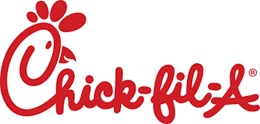
Figure 1- Logo of Chic-fil-A
(Source: Chick-fil-A, 2017)
Established in the year 1946, May, Chic-fil-A is a fast food chain restaurant, which is based in America. It was founded by Truett Cathy and the first outlet was opened in Atlanta. Within three years of its operation, the company started to expand by opening new outlets in food courts of malls. Later in 1986, the company opened its first freestanding franchise in Georgia and since then the company has focused on opening more franchise rather than going for mall's food court. It currently has more than 2,000 outlets in U.S and is the eight largest company for fast food by sales. With licensing agreements, Chic-fil-A has been able to open outlets in universities, airports and hospitals. The founder of the company strongly believed that he and the employees of Chic-fil-A should set aside Sundays for their family and take a day off. The company still upholds this practice.
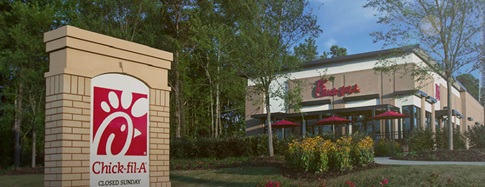
Figure 3
(Source: Chick-fil-A, 2017)
Importance of PESTEL and Its application
PESTEL stands for "Political, Economical, Social, Technological, Legal and Environmental". PESTEL analysis is done to identify numerous factors, which affect the external environment of the organization. This analysis provides the companies with a very simple framework to analyze the factors that can cause risk to their companies. The process of this analysis involves knowledge and cross-functional skills. The companies can use this method of analysis to reduce the impact of the potential threats (Issa et al. 2010, p.78). PESTEL analysis enables the organizations to exploit new opportunities and find new ways to enter both the national and global market. The companies can develop different strategies to meet the objectives of the organization. This can assist the managers to deal with the errors that causes performance gap.
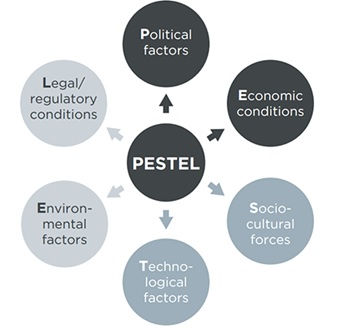
Figure 4
(Source: Issa et al. 2010, p.78)
- Political Factors- Under this factor, the rules and regulations of the government are assessed that can influence the environment of the business. The political stability, government support, etc. are the main issues that are considered.
- Economic Factors- The organizations have to understand the impact of the economic factors on their business. These factors include the economic growth, inflation, unemployment rate, monetary policies, consumer confidence, etc (Ali et al. 2010, p.122).
- Social Factors- With this factor, the business organizations can understand the elements of consumer needs and understand how the customers shape the business operations and influence the business decisions. These factors include lifestyle of the customers, cultural limitations, customer demographics, income distribution, labour mobility, etc.
- Technological Factors- The technological factors play an important role in fostering the business growth. These factors include new development and inventions, changes in the technology, importance of internet, government spending on technological research, lifecycle of the technologies, etc (Jayasankara Prasad and Ramachandra Aryasri, 2011, p.82).
- Environmental Factors- The environment in which the company operates, influence the business operation of the company. Hence, it is important for the companies to understand the environmental regulations and protect it as well (Albiñana and Vila, 2012, p.442).
- Legal Factors- Every company should abide the rules and laws stated by the country in which it operates. These factors should be considered to run the business legally. The factors are employment laws, safety regulations, tax policies, competition regulations, etc.
It is important to use the PESTEL analysis, especially before entering new markets. This would give them the idea to formulate strategies accordingly and operate their business processes in the new place of work effectively.
PESTEL Analysis for India with regard to "Chick-Fil-A"
The company owns all the outlets and the company decides about the location where they want to open a new franchise. The cost of initial investment for becoming the franchise operator of Chic-fil-A is just $10,000. The company is looking forward to enter the Indian marketplace. As the management consultant, the learner has analyzed the external environment of the Indian market for Chick-fil-A.
The manager consultant has taken the help of PETSEL analysis to find out about the external environment of the Indian market to analyse the market for fast food chains and to decide whether Chick-fil-A should consider entering the Indian market. The manager consultant has taken three factors from the PESTEL analysis tool to do so. The three factors are Economical, Social and Environmental. The manager of Chick-fil-A did research on economic growth, inflation, unemployment rate and monetary policies of the Indian market so that it is easier for the company to decide whether they should open their franchise in India (Belz and Schmidt‐Riediger, 2010, p.405).
Economical Factor
Chick-fil-A is a fast food chain that serves in America. The fast food is mostly consumed by the age group of 10-24 years. In America, the company Chick-fil-A has been serving more than 64 million people. The population of India stands at 1.311 billion where only 3,000 fast food chains serve the consumer market. The fast food industry of India is becoming one of the major markets and is being targeted by numerous internal food chains brands (Nestle, 2013,p.134). The market of India is very nascent and the international brands can have the opportunity to enter the market and coexist. The disposable income of this age group is comparatively lower than the other age groups (Paunescu, 2013, p.63). The market for fast food in India is expected to grow at an 8% CAGR. As the population of the country is floating in the metropolitan cities, the young people from the age group of 10-24 are expected to consumer more fast food in the coming years. The company Chick-fil-A would have to maintain the consistency of its brand to serve 1.311 billion people, out of which 356 million people belong to age the age group of 10-24. This age group needs more diverse menu to fulfil their needs for fast food (Brown, 2010, p.220).
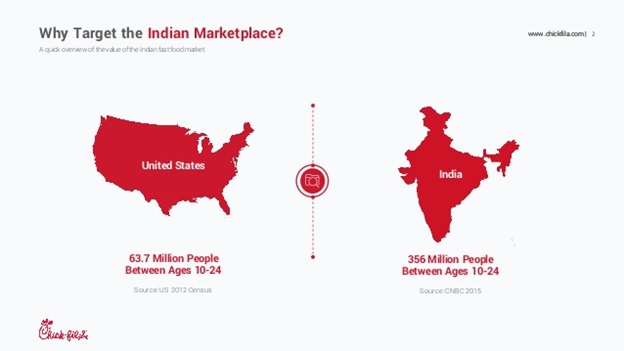
Figure 5
(Source: Brown, 2010, p.220)
As per the International Journal of Application in Engineering and Management, it has been found out that 80% of the Indians of the Metropolitan cities visit the fast food restaurants at least once in a week (ijemr, 2017). This means that it Chick-fil-A would have high demand for its products and good number of customers. The company has to follow the monetary policies to operate in the Indian market. There have some major investments in the Indian food-processing sector. The country has received USD $7 billion of FDI in the last year, which means the country has the potential to make good positions for the fast food companies (Majumdar, 2010).
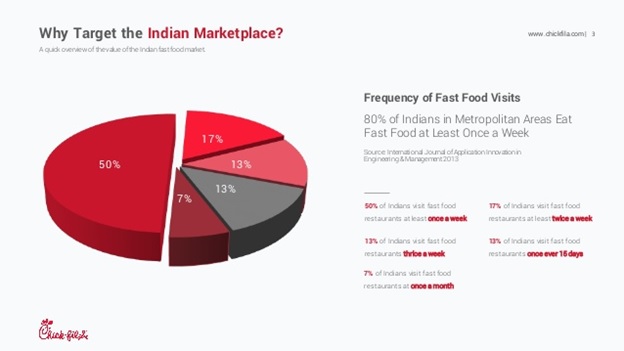
Figure 6
(Source: ijemr, 2017)
The Indian Fast Food Market is also expected to grow at a rate of 7% every year.Hence, the economic factors of the Indian market are favourable for Chick-fil-A to establish their first franchise in this market.
Social Factors
These factors play an important role in affecting the growth and success of any organization. In India, the people have become more aware of the importance of healthy lifestyle. They expect the fast food companies to hygienic nutritional food products. The international fast food brands that enter the Indian Market have to consider the cultural believes of the Indian customers. India being a diverse country, most of the customers prefers to have spicy food (Peter and Donnelly, 2011). Therefore, the company can alter its recipes and 'Indianize' their food items to attract more customers. For example, 75% of the population in India are Hindus who do not consumer beef products and there are some customers who are strictly vegetarians. These customers are large in number and they do not consume meat products. Since, Chick-fil-A aims at entering the Indian Fast Food Market, it has to consider these factors. The corporate culture of Chick-fil-A must be very strong and it must promote diversity, equality and integrity (Solomon, 2014).
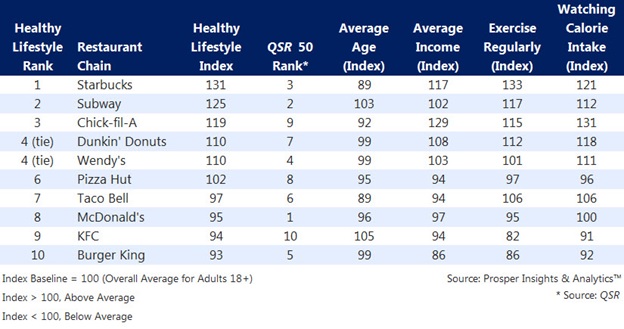
Figure 7
(Source: Peter and Donnelly, 2011)
As there are good numbers of non-vegetarian consumers, the company can easily serve their needs. The company has to address the dietary and religious dissimilarity between their country and India so that they can design message for the consumers of the Indian Marketplace. The restaurant, Chick-fil-A is famous for chicken sandwiches and they do not serve beef in their food items (Kaushik et al. 2011, p.100).
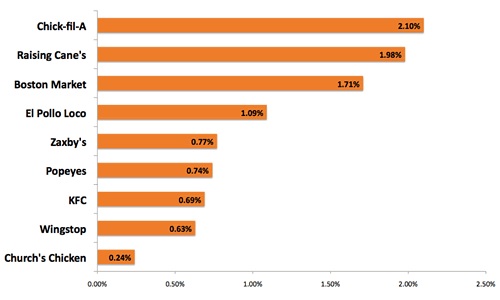
Figure 9
(Source: Counihan and Van Esterik, 2012)
This would give them an advantage in attracting those customers who do not consumer beef. As they would have to hire employees after settling in, they would also have to consider the cultural difference between the workplace of both the countries (Counihan and Van Esterik, 2012). The company has to study the market of the food industry in India to have an understanding of the average price of the most demanded fast food items. This would help them decide the cost of their products. There are companies like KFC, McDonald's, Burger King, which are leading the Indian Market at present.
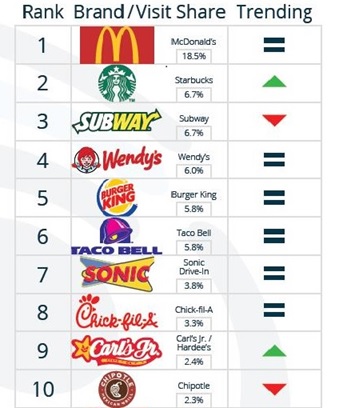
Figure 8
(Source: Solomon, 2014)
However, the consumers of the country are always ready to experiment with new food outlets, especially the international food brands. As Chick-fil-A is the most favourite chicken food chain in America, it would be easier for the company to grab the market for the non-vegetarians.
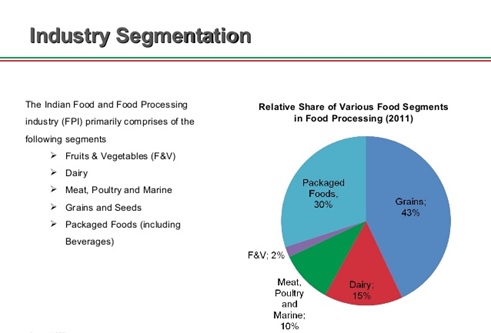
Figure 10
(Source: Rothaermel, 2015)
The consumer market of India can be segmented on the basis of demographic, geographic, psychographic and behavioural factors, The company has to follow this process and indentify the potential customers for their products and services. The food industry of the Indian Market can be segmented in the similar way and it has been shown in Figure 10. As the share of packaged food is relatively more than meat and poultry, Chick-fil-A can consider this as a new product. This would not only require new business plans, they would also need more people to research on the taste and preference of the customers of Indian Marketplace.
Environmental Factors
The company, Chick-fil-A features Holstein dairy cows in their advertisements. The advertisement's main motive is to spread the slogan "EAT MOR CHIKIN" (Seaman, 2012). The Richards Group created this slogan and since then, it is seen in every advertisement of Chick-fil-A. They try to endorse the fact that people should eat more chicken instead of beef. As India is country where majority of the population are Hindu, this slogan would help the company to attract more customers (Rothaermel, 2015).

Figure 11
(Source: Chick-fil-A, 2017)
However, the company can face the threats from the vegetarian customers, as the number of items from the menu available for them would be very limited (Johanson and Vahlne, 2011, p.488). The company has to come up with new items and they have to promote the products in the right way. Chick-fil-A has to keep the prices of the product affordable, as there are many international fast food chains in India. As the company does not serve beef, it would help them to create a friendly environment. India has made various legal changes for the business organizations (Roger, 2010). To control the pollution level in the country, the government has established regulations on noise control, disposal and waste control. Chick-fil-A has to go through these regulations to understand that it is important to protect the environment of the country (Fetscherin, 2010, p.469).
Conclusion and Recommendations
The Indian Market for the fast food has been growing immensely. Chick-fil-A is an American fast food company, which is one of the most favourite food chain of America. As the company aims at entering the Indian Marketplace, it has to consider various factors. India has a huge population and most of the people have demand for fast food. The company Chick-fil-A has to study the areas in which they make alterations to enter the market and sustain for long. There are well-established fast food international brands in India already. Hence, Chick-fil-A has to formulate new strategies to take over the market and serve the customers the right products and services. As the company does not serve beef and it promotes the slogan 'eat mor chicken', this can give the company an advantage to attract those customers who do not consume beef for religious purpose. The company should keep the price of the products at moderate level and bring changes in their food menu. As Indian Market is this vast and most of the external environmental factors are in support of bringing in more international food chain brands, Chick-fil-A can enter the market and establish their first franchise in India.
Reference List
Books
Peter, J.P. and Donnelly, J.H., 2011. Marketing management: knowledge and skills: text, analysis, cases, plans. Plano: Business pub., INC.
Majumdar, R., 2010. Consumer behaviour: Insights from Indian market. PHI Learning Pvt. Ltd..
Solomon, M.R., 2014. Consumer behavior: Buying, having, and being (Vol. 10). Engelwood Cliffs, NJ: Prentice Hall.
Counihan, C. and Van Esterik, P., 2012. Food and culture: A reader. Routledge.
Rothaermel, F.T., 2015. Strategic management. New York, NY: McGraw-Hill.
Roger, K., 2010. Strategic Marketing Problems: Cases And Comments, 12/E. Pearson Education India.
Journals
Seaman, D., 2012. Chick-fil-A.
Johanson, J. and Vahlne, J.E., 2011. Markets as networks: implications for strategy-making. Journal of the Academy of Marketing Science, 39(4), pp.484-491.
Ali, J., Kapoor, S. and Moorthy, J., 2010. Buying behaviour of consumers for food products in an emerging economy. British Food Journal, 112(2), pp.109-124.
Fetscherin, M., 2010. The determinants and measurement of a country brand: the country brand strength index. International Marketing Review, 27(4), pp.466-479.
Kaushik, J.S., Narang, M. and Parakh, A., 2011. Fast food consumption in children. Indian Pediatrics, 48(2), pp.97-101.
Issa, T., Chang, V. and Issa, T., 2010. Sustainable business strategies and PESTEL framework. GSTF International Journal on Computing, 1(1), pp.73-80.
Albiñana, J.C. and Vila, C., 2012. A framework for concurrent material and process selection during conceptual product design stages. Materials & Design, 41, pp.433-446.
Belz, F.M. and Schmidt‐Riediger, B., 2010. Marketing strategies in the age of sustainable development: evidence from the food industry. Business Strategy and the Environment, 19(7), pp.401-416.
Nestle, M., 2013. Food politics: How the food industry influences nutrition and health (Vol. 3). Univ of California Press.
Brown, S., 2010. Where the wild brands are: Some thoughts on anthropomorphic marketing. The Marketing Review, 10(3), pp.209-224.
Paunescu, C.M., 2013. Challenges of entering the business market: the pre-entry knowledge and experience. Management & Marketing, 8(1), p.63.
Jayasankara Prasad, C. and Ramachandra Aryasri, A., 2011. Effect of shopper attributes on retail format choice behaviour for food and grocery retailing in India. International Journal of Retail & Distribution Management, 39(1), pp.68-86.
Websites
ijemr (2017). International Journal of Engineering and Management Research (IJEMR). [online] Ijemr.net. Available at: http://www.ijemr.net/IJEMR/Home.aspx [Accessed 14 May 2017].
Chick-fil-A (2017). Who We Are. [online] Chick-fil-A. Available at: https://www.chick-fil-a.com/About/Who-We-Are [Accessed 14 May 2017].


